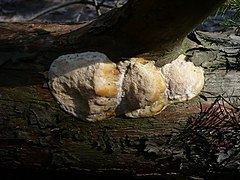Diplomitoporus
| Diplomitoporus | |
|---|---|

| |
| Diplomitoporus flavescens | |
| Scientific classification | |
| Kingdom: | |
| Division: | |
| Class: | |
| Order: | |
| Family: | |
| Genus: | Diplomitoporus Domański (1970)[1]
|
| Type species | |
| Diplomitoporus flavescens (Bres.) Domański (1970)
| |
| Synonyms[3] | |
| |
Diplomitoporus is a genus of fungi in the family Polyporaceae. The Dictionary of the Fungi (10th edition, 2008) estimated the widespread genus to contain 11 species;[4] since then, the genus has grown with the additional of several newly described species, and some transfers from other genera. Diplomitoporus has been described as a wastebasket taxon, containing "species that share common macroscopic and microscopic characteristics, but are not necessarily related."[5]
Diplomitoporus was circumscribed in 1970 by Polish mycologist Stanislaw Domanski, with Diplomitoporus flavescens as the type species.[1] This species was originally described as a member of Trametes by Giacomo Bresadola in 1903.[6]
Species[edit]
As of June 2017[update], Index Fungorum accepts 21 species of Diplomitoporus:[7]
- Diplomitoporus allantosporus Ryvarden & Iturr. (2003)[8] – Venezuela
- Diplomitoporus costaricensis I.Lindblad & Ryvarden (1999)[9] – Costa Rica
- Diplomitoporus crustulinus (Bres.) Domanski (1970) – Europe; North America
- Diplomitoporus cunninghamii P.K.Buchanan & Ryvarden (1998)[10] – New Zealand
- Diplomitoporus daedaleiformis (Henn.) Ryvarden (2014)
- Diplomitoporus flavescens (Bres.) Domanski (1970) – Europe
- Diplomitoporus globisporus Ryvarden (2013)[11] – Brazil
- Diplomitoporus hondurensis (Murrill) Ryvarden (2000) – Belize
- Diplomitoporus incisus Ryvarden (2000)[12] – Puerto Rico
- Diplomitoporus insularis Ryvarden (2009)[13] – Seychelles
- Diplomitoporus intermedius Baltazar & Ryvarden (2013)[11] – Brazil
- Diplomitoporus marianoi-rochae G.Coelho (2008)[14]
- Diplomitoporus meridionalis M.Pieri & B.Rivoire (1998)[15]
- Diplomitoporus microsporus Iturr. & Ryvarden (2010)[16]
- Diplomitoporus navisporus Gibertoni & Ryvarden (2004)[17] – Brazil
- Diplomitoporus overholtsii (Pilát) Gilb. & Ryvarden (1985) – Uganda
- Diplomitoporus stramineus Ryvarden & Iturr. (2003)[8] – Venezuela
- Diplomitoporus sulphureus (Petch) Ryvarden (2015)
- Diplomitoporus taquarae G.Coelho (2008)[14]
- Diplomitoporus venezuelicus Ryvarden & Iturr. (2003)[8] – Venezuela
References[edit]
- ^ a b Domanski S. (1970). "Wood-inhabiting fungi of Bialowieza virgin forests in Poland. XIII. Two species of Diplomitoporus Doman., gen. nov". Acta Societatis Botanicorum Poloniae. 39: 191–207. doi:10.5586/asbp.1970.016.
- ^ Zmitrovich IV. (2001). "Some new combinations in Polyporaceae: sapienti sat". Mycena. 1 (1): 91–93.
- ^ "Diplomitoporus Domanski 1970". MycoBank. International Mycological Association. Retrieved 2011-11-20.
- ^ Kirk, P.M.; Cannon, P.F.; Minter, D.W.; Stalpers, J.A. (2008). Dictionary of the Fungi (10th ed.). Wallingford, UK: CABI. p. 212. ISBN 978-0-85199-826-8.
- ^ Miettinen, Otto; Larsson, Karl-Henrik (2011). "Sidera, a new genus in Hymenochaetales with poroid and hydroid species". Mycological Progress. 10 (2): 131–141. doi:10.1007/s11557-010-0682-5. S2CID 23786160.
- ^ Bresadola, G. (1903). "Fungi Polonici a cl. Viro B. Eichler lecti". Annales Mycologici. 1 (1): 65–96.
- ^ Kirk, P.M. "Species Fungorum (version 29th May 2017). In: Species 2000 & ITIS Catalogue of Life". Retrieved 2017-06-05.
- ^ a b c Ryvarden, L.; Iturriaga, T. (2003). "Studies in neotropical polypores 10. New polypores from Venezuela". Mycologia. 95 (6): 1066–1077. doi:10.1080/15572536.2004.11833021. JSTOR 3761913. PMID 21149014. S2CID 42996705.
- ^ Lindblad, I.; Ryvarden, L. (1999). "Studies in neotropical polypores. 3. New and interesting Basidiomycetes (Poriales) from Costa Rica". Mycotaxon. 71: 335–359.
- ^ Buchanan, P.K.; Ryvarden, L. (1998). "New Zealand polypore fungi (Aphyllophorales): three new species and a new record". New Zealand Journal of Botany. 36 (2): 219–231. doi:10.1080/0028825x.1998.9512563.
- ^ a b Baltazar, J.M.; Ryvarden, L.; Gibertoni, T.B. (2014). "Diplomitoporus (Polyporales, Agaricomycetes) in Brazil revisited". Mycological Progress. 13: 313–319. doi:10.1007/s11557-013-0916-4. S2CID 255309284.
- ^ Ryvarden, Leif (2000). "Studies in neotropical polypores. 5. New and noteworthy species from Puerto Rico and Virgin Islands". Mycotaxon. 74 (1): 119–129.
- ^ Hjortstam, K.; Ryvarden, L. (2009). "A preliminary checklist of Aphyllophorales from the Seychelles". Synopsis Fungorum. 26: 10–23.
- ^ a b Coelho, G. (20 February 2008). "Diplomitoporus marianoi-rochae G. Coelho, sp. nov" (PDF). Fungal Planet (26).
- ^ Pieri, M.; Rivoire, B. "A propos de quelques polypores (Aphyllophoromycetideae) rares ou critiques récoltes récemment. II". Bulletin de la Société Mycologique de France (in French). 114 (2): 39–52.
- ^ Ryvarden, L.; Iturriaga, T. (2010). "Studies in Neotropical polypores 29. Some new and interesting species from the Andes region in Venezuela". Synopsis Fungorum. 27: 78–91.
- ^ Gibertoni, T.B.; Ryvarden, L.; Queiros Cavalcanti, M.A. (2004). "Studies in neotropical polypores. 18. New species from Brazil". Synopsis Fungorum. 18: 44–56.
